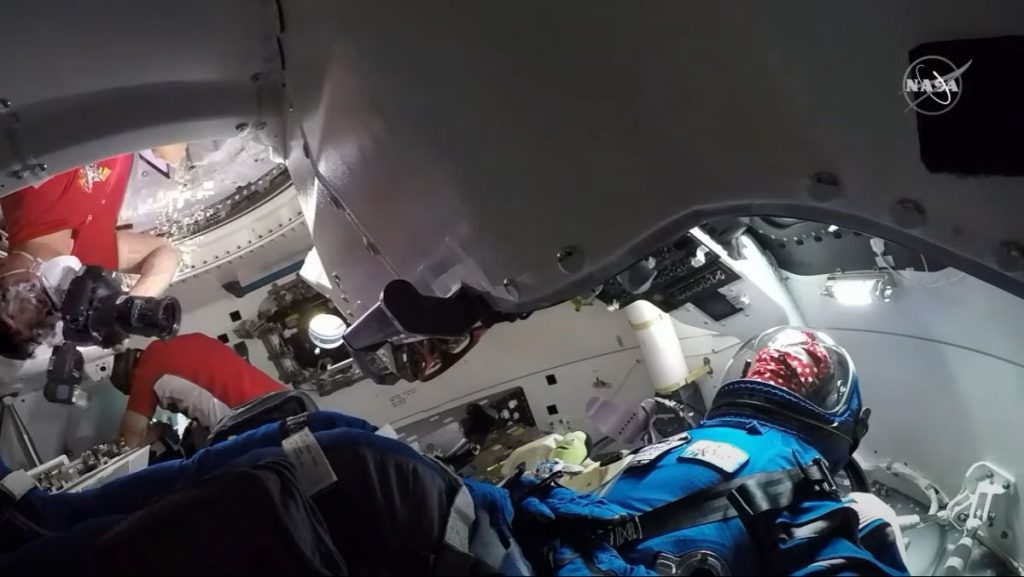Boeing’s first Starliner capsule to the International Space Station is officially open for astronauts living on board the orbiting lab.
The commercial Starliner spacecraft, which arrived Friday on an uncrewed test flight to the station, was opened by NASA astronaut Robert Hines at 12:04 p.m. EDT (1604 GMT) to begin about five days of tests on the capsule. It’s a major milestone for Boeing and NASA’s Commercial Crew Program, which picked Boeing and SpaceX to fly astronauts to the International Space Station in 2014.
“This is the day that they envisioned, where we have three human-rated vehicles docked at the space station right now,” Hines said, referring to Starliner, SpaceX’s Crew Dragon and Russia’s Soyuz capsule. “So this is a momentous day in NASA’s history and just paving the way for the future as we start enabling commercial flight shere in low Earth orbit while NASA visits to the moon and eventually on to Mars.”
Live updates: Boeing Starliner Orbital Flight Test 2 mission to ISS
Related: Boeing’s Starliner OFT-2 test flight for NASA in amazing photos
SpaceX has flown five astronaut flights for NASA since May 2020 but Boeing’s Starliner has had a rockier road.
Starliner failed to reach the ISS during the first OFT in December 2019 due to software glitches, and then had its second attempt scrubbed hours before liftoff in August 2021 of after the mission team discovered stuck valves in the capsule’s propulsion system. Those problems did not resurface for Starliner’s current test flight, called Orbital Flight Test-2 (OFT-2). (Though there have been some minor thruster and cooling system glitches and a slight delay during docking.)
“Those are the kinds of things we expect in flight test and that is why we test,” Hines said Saturday. “If we didn’t find something like that we’re probably doing something wrong.”
The thruster malfunctions shortly after Thursday’s launch don’t appear to be related to the previous issues the vehicle has experienced. At a post-launch press briefing Thursday night, NASA and Boeing representatives doubled down on their confidence in Starliner to complete its mission, regardless of the new thruster problems.
“The system is designed to be redundant, and it performed like it was supposed to,” said Mark Nappi, vice president and program manager for Boeing’s commercial crew program.
Starliner spent Thursday night chasing down the orbital laboratory, and it began executing rendezvous test maneuvers just after 3:30 p.m. EDT (1930 GMT) on Friday. Before moving to dock, the capsule successfully demonstrated its ability to stop on command as well as retreat away from the station in case of emergency.
Satisfied with the results, Boeing flight operators instructed Starliner to begin docking procedures, and the vehicle started its slow progression toward the station’s Harmony module. At 8:28 p.m. EDT on Friday (0028 GMT on May 21), Starliner officially docked with the International Space Station.
Over the next few days, crewmembers aboard the orbiting lab will empty Starliner of 500 pounds (226 kilograms) of supplies and provisions, then pack its hull with nearly 600 pounds (270 kg) of cargo marked for return to Earth.
Staying on board Starliner will be Boeing’s test dummy, affectionately dubbed Rosie the Rocketeer, after Rosie the Riveter of World War II-era fame. Clad in one of Boeing’s blue spacesuits, Rosie will stay strapped into Starliner’s command seat for the ride back to Earth.
Sensors on Rosie were used to measure g-forces experienced on the body during Strainer’s first test flight. On OFT-2, the sensors are now being used to measure those same forces’ effects on Starliner’s seats during reentry and landing. Starliner is scheduled to return to Earth following a four- to five-day stay at the space station, a timeline largely dictated by weather at the vehicle’s potential landing sites in the western United States.
Boeing also added an extra bit of fun to Starliner’s trip to the space station in the form of a plush toy of Jebediah “Jeb” Kerman, a Kerbonaut from the hit space exploration game Kerbal Space Program, which Boeing used as a zero-g indicator to show when the capsule reached space.
Editor’s note: This story, initially posted at 9:30 a.m. EDT, was updated at 2 pm ET with details from Starliner’s hatch opening by astronauts.
Follow us on Twitter @Spacedotcom or on Facebook.

